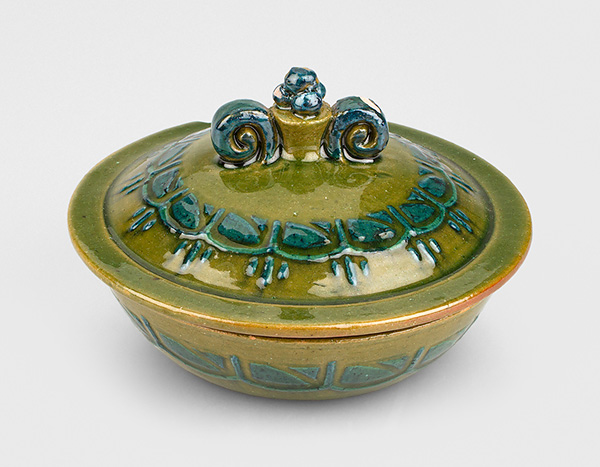
Made by Bendicht Loder-Walder, Heimberg, to a design by Nora Gross-Perret, 1905 (MHL No. 14).
Pottery by Nora Gross in CERAMICA CH
Andreas Heege and Roland Blaettler, 2023
Cécile-Éléonore, alias Nora Gross (1871–1929), trained as an arts teacher at the Basel School of Design and afterwards at the Winterthur School of Engineering, where she was awarded her diploma in 1890. Her keen interest in the applied arts brought her to the Geneva School of Design, where she attended a pottery decoration course under the tutelage of Joseph Mittey. Between 1893 and 1903, she taught at the School of Higher Education for girls in Morges before founding her own school of Drawing and Arts and Crafts in Lausanne, which merged with the Cantonal School of Drawing in 1924.
In an attempt to enhance the aesthetic appeal of vernacular arts and crafts and to support the continuation of cottage industries, which were under threat from industrialisation, she initiated the founding of the Société d’art domestique (Society of Cottage Industry Workers) in 1911, and in 1913, was one of the founders of L’Œuvre, the French-speaking section of the Schweizerischer Werkbund. She also got married in 1913 to Paul Perret (1880–1947), art critic, secretary of L’Œuvre and politician (grand council member, mayor, and later member of the council of state from 1931 to 1942).

Nora Gross-Perret (Ball-Spiess 1987, fig. 45).
During her early years as a teacher Nora Gross focused on oil and watercolour painting. Her main motifs were landscapes and floral themes. When she founded her school in Lausanne around the turn of the century she began to concentrate more on the field of applied arts or arts and crafts. She created models and designed modern motifs for the textile and pottery industries. Her main artistic contribution would have been in printed textiles. Her contribution to the field of pottery was to revive and enhance the traditional craft (slipped earthenware), particularly in the Heimberg-Steffisburg region.
Her first collaboration with a pottery manufacturer dates back to 1902/03 when she supplied the company Veuve Knecht et fils in Colovrex (Canton of Geneva) with her first model drawings. The Musée Ariana houses eleven pieces from the former Museum of Decorative Arts in Geneva (Inv. C 0308, C 0309, C 0310, C 0322, C 0326, C 0327, C 0328, C 0329, C 0330, C 0348 and C 0350 – Ball 1988, Cat. No. 1, 3, 4, 6, 8, 9, 12, 13, 17, 21 and 22).
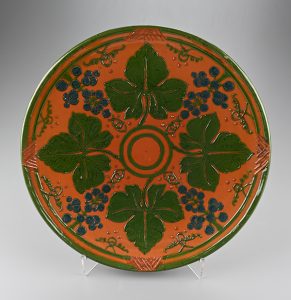
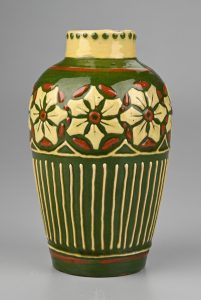

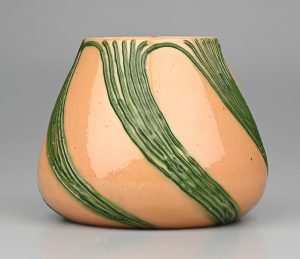

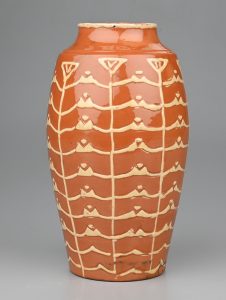
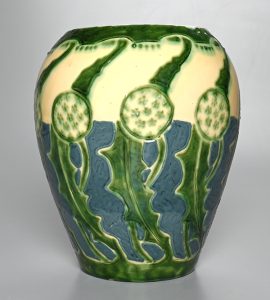
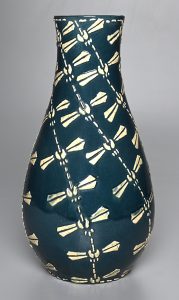
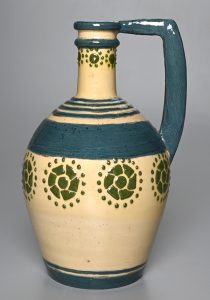
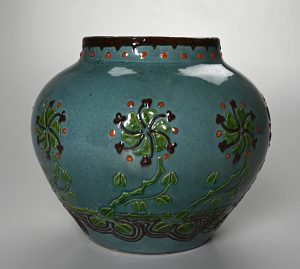
Pottery designs by Nora Gross and the Knecht potteries in the Musée Ariana in Geneva (all unmarked).
The objects are unmarked, but the old inventory clearly identifies them as “rustic pottery” created by Miss Gross and for the most part purchased from the Knecht potteries between late 1903 and early 1904. It is also known that the product line was named “Hera” after the Greek Goddess, protectress of women and marriage.
In December 1903, Nora Gross exhibited ceramics from the Hera line in the shop windows of the Swiss Furniture Society on Place Saint-François in Lausanne (Gazette de Lausanne dated 30th December 1903, 3). Emphasising the “very simple shapes with monochrome glaze and sober decorations consisting of floral or geometric ornaments whose appeal is in the simplicity of their style […] The ornamentation is in perfect harmony with the rustic material”, the article mentions that four ceramics have been purchased by the Museum of Decorative Arts in Geneva.
The collaboration with the Knechts was short-lived because she was dissatisfied with their work. Nora Gross soon turned to a different producer in Heimberg, one of the historical centres of traditional Bernese pottery manufacture: Bendicht Loder-Walder.
1903/1904 According to Daniela Ball the fruitful collaboration between Bendicht Loder-Walder and the ceramic designer Nora Gross from Lausanne began in 1903 (Ball 1987, 111 – see also Messerli Bolliger 1991, 74, Fig. 45). In an article published in the NZZ on 20th November 1906, the unknown editor described a trip he made to Heimberg in August 1904 in search of the potter and workshop that had produced such modern pottery. Having visited two workshops that were producing Thun majolica with Edelweiss motifs on the one hand and modern slip-trailed decoration on the other, similar to pottery “that is sold from the stands under the arches on Limmatquai”(Wächter-Reusser Pottery), he eventually found the Loder-Walder workshop. “A magnificent harvest wagon was being unloaded when we arrived, which required all hands on deck. As a consequence, the welcome was not particularly friendly; it was only when the owner realised that we were interested in his wares that he became more talkative and began to produce several of Miss Gross’s lovely patterns while telling us about his orders from Interlaken and his deliveries to Berlin. We were having such a wonderful conversation that we were almost too late getting back to the train station, laden as we were with Heimberg ceramics. This is what we were reminded of when we spotted the ceramic objects [in December 1906] on display at the Weil art dealership on Bahnhofstrasse [in Zurich]. Hopefully they will find a ready market here, as these are genuine Swiss products and wholesome indigenous works of art.”
In the autumn of 1904 ceramic works by Nora Gross were exhibited at the Swiss National Fine Arts Exhibition at the Palais de Rumine in Lausanne (La Liberté 34, No. 223, 29th September 1904; Le Confédéré de Fribourg, 57, No. 81, 9th October 1904, and in the Gazette de Lausanne, review by Maurice Wirz; Ball-Spiess 1987, 152). On that occasion, the Museum of Decorative Arts in Geneva purchased a glazed terracotta object by Nora Gross. We cannot say for certain whether she was already presenting her Heimberg wares at this particular exhibition, or whether these were still the objects made by the Knechts.
The next time her novel ceramic creations were mentioned was in 1905 in respect of a very successful exhibition of her works at the Cantonal Museum of Decorative Arts in Bern (Le Nouvelliste vaudois dated 3rd May 1905, 2 – Gazette de Lausanne dated 13th May 1905, 3 and 5). As an aside it should be noted that the report in Le Nouvelliste provides a potential reason why Gross and the Knechts parted ways: “Miss Gross had initially been looking among the craftspeople in Ferney [the error in pinpointing the correct location occurred because the Knechts also had a workshop in Ferney-Voltaire] for a potter who would be capable of working to her designs; fortunately, however, the prejudices she encountered convinced her to broaden her search for the most suitable candidate to all of Switzerland. She eventually found him in Heimberg.”
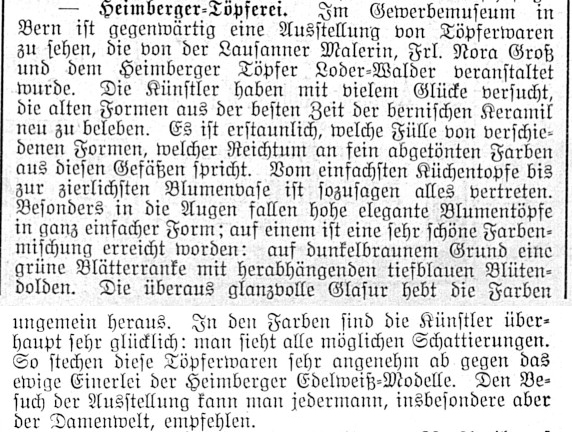
Report on the exhibition at the Museum of Arts and Crafts in Bern in the “Geschäftsblatt für den oberen Teil des Kantons Bern”– 52, No. 36, dated 6/6/1905.
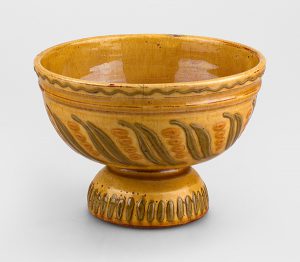
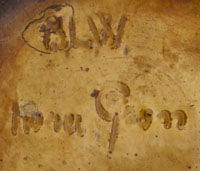
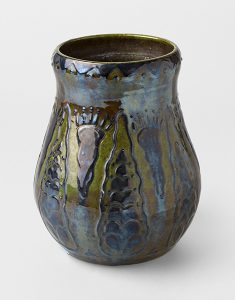
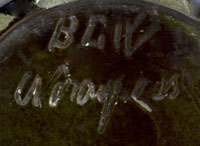
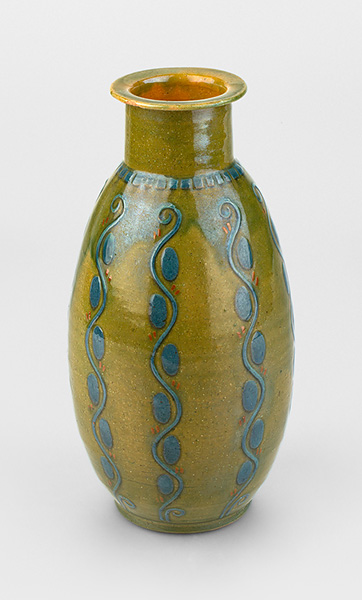
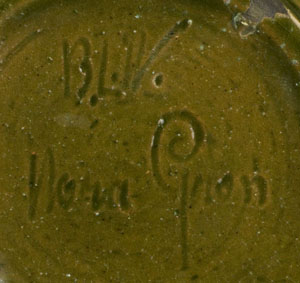
Pottery produced by Bendicht Loder-Walder and Nora Gross in the collection of the Historical Museum in Lausanne.
The vast majority of the ceramics produced by Loder-Walder bear the incised mark “BL (or BLW) – Nora Gross” and an incised number that identifies the shape. Five pieces are in the collection of the Historical Museum in Lausanne (MHL No. 14; MHL No. 17; MHL No. 18; MHL No. 25; MHL No. 26), three are at the School of Visual Arts and Design in Bern and Bienne.
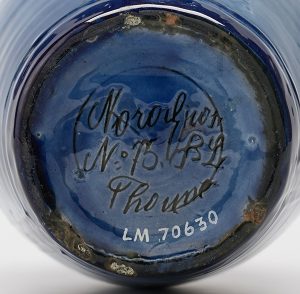
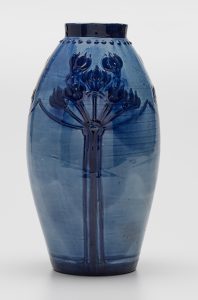
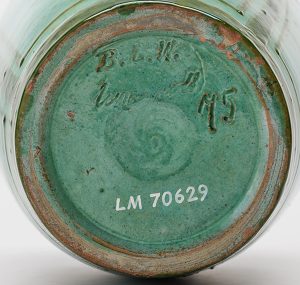
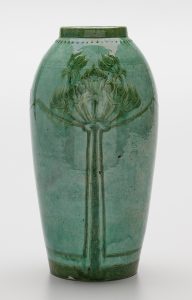
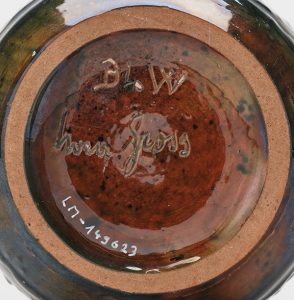
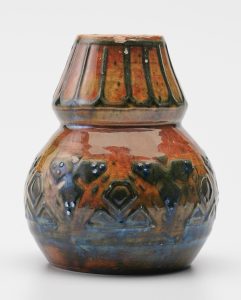
The Swiss National Museum in Zurich has three vases by Nora Gross and Bendicht Loder-Walder (SNM LM-70629, SNM LM-70630, SNM LM-149623) marked “BL Thoune” or “BLW”.
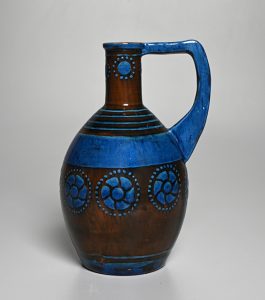

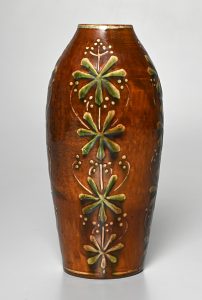
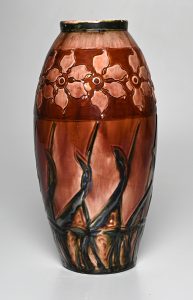


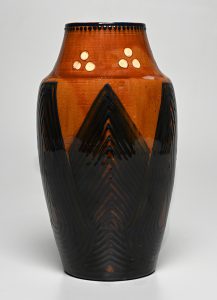
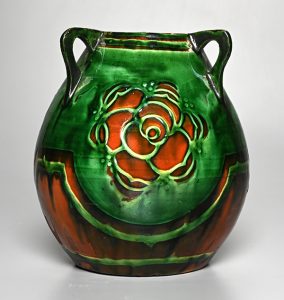


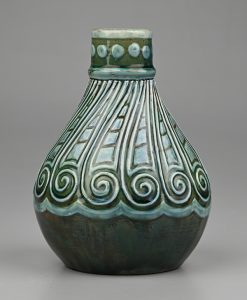

The Musée Ariana has 15 objects from this category, which were acquired from the former Museum of Arts and Crafts in Geneva in 1905 and 1906 (see Ball 1988 Cat. No. 2, 5, 7, 8, 10, 11, 14-16, 18-20, 23-26).
A further five examples can be found in the collection of the Lerbermatt Secondary School in Köniz (Kön-Lerb_01 to Kön-Lerb_05). Unfortunately, we do not know when these pieces found their way into the collections of its predecessor institution, the State Seminary Bern – Lerbermatt. The marks on these pieces obviously differ from those on the last-mentioned group, but we have no information as to why the mark was changed.
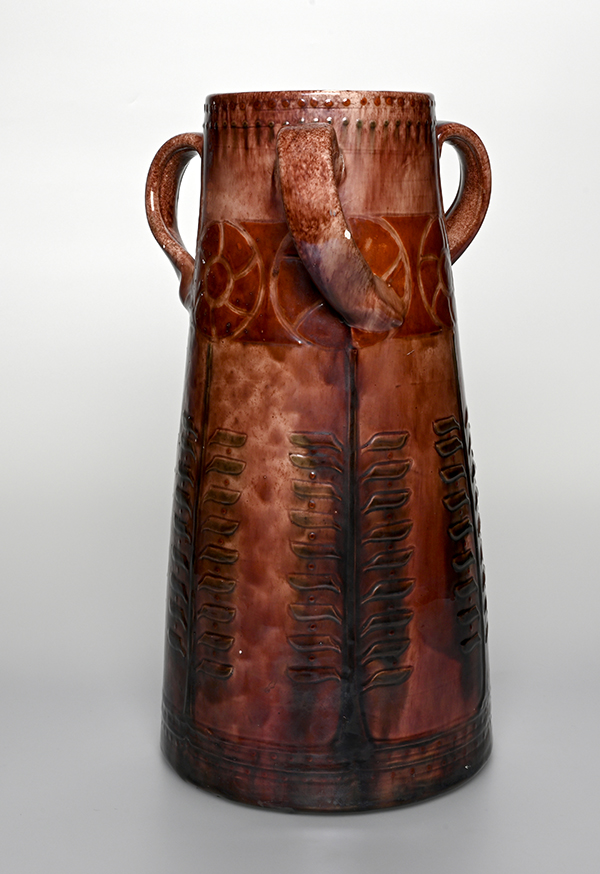
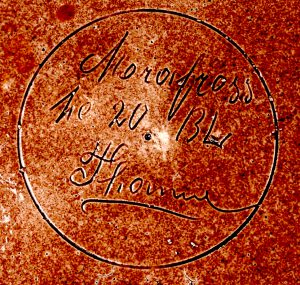
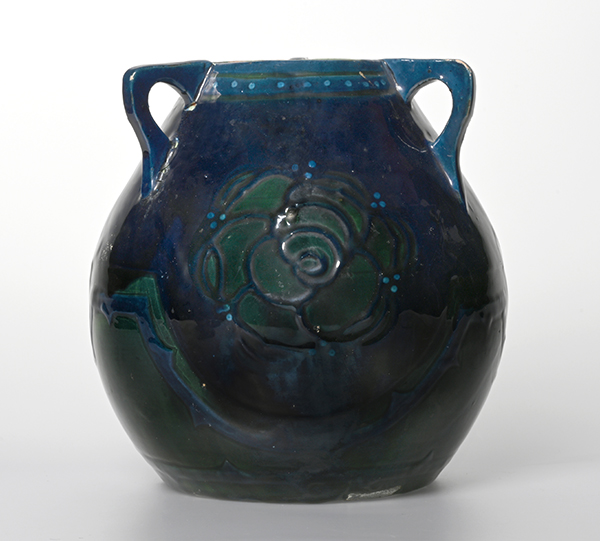
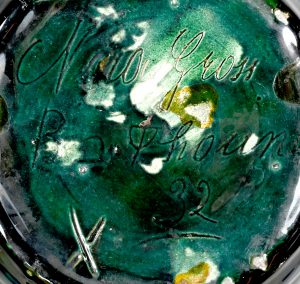

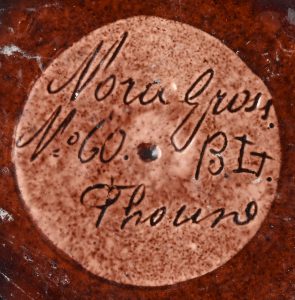

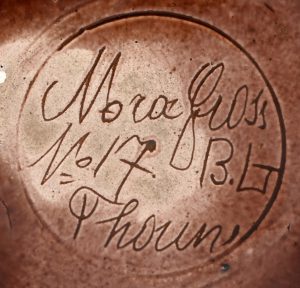
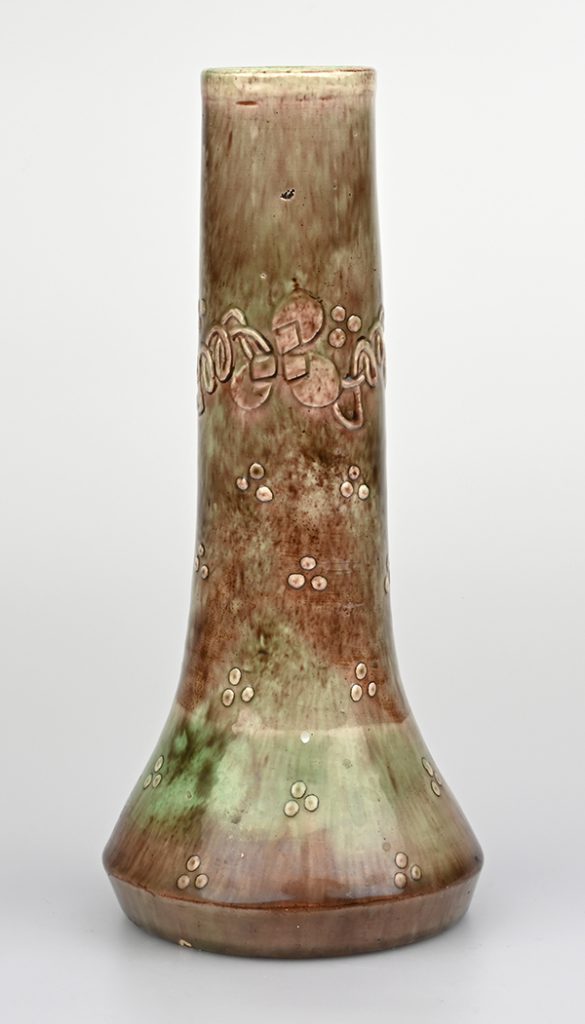
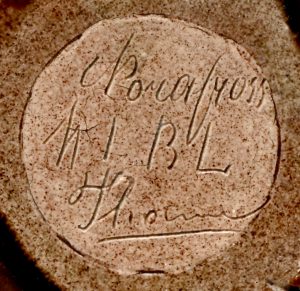
Collection of the Lerbermatt Secondary School in Köniz, marked “BL Thoune”.
The collaboration with Bendicht Loder resulted in a product line that was much more refined, particularly in terms of colour. The slipped decorations were no longer covered in a simple colourless glaze as produced by Knecht but with polychrome glazes in a rich array of colours and with highlights in the poured-slip technique.

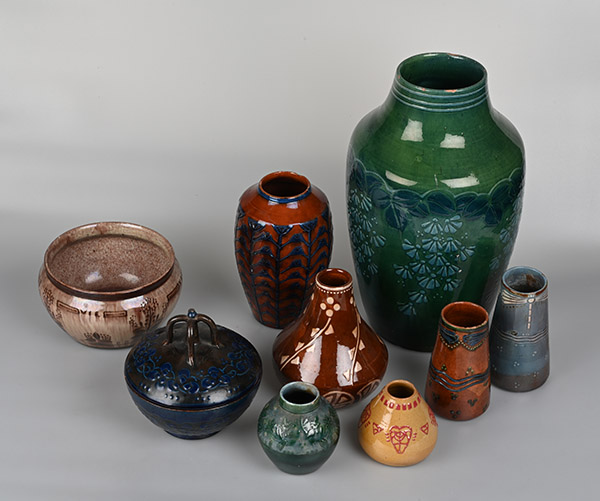
The ceramics produced by Loder-Walder bear the incised mark “BL (or BLW) – Nora Gross” and a stamped or incised number that identifies the shape. Private collection.
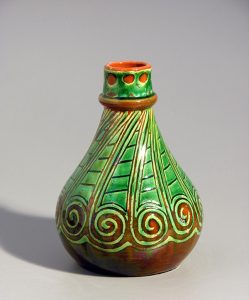
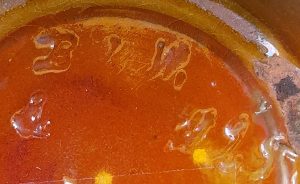
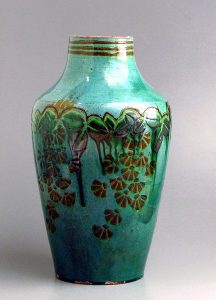


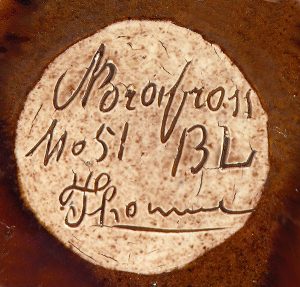
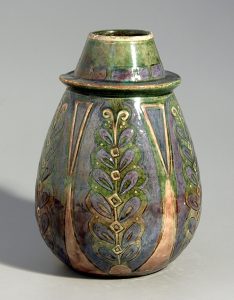
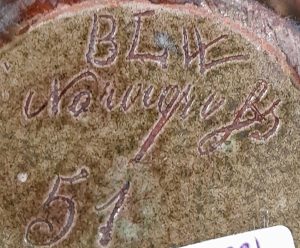
Pottery by Nora Gross and Bendicht Loder-Walder can also be found in several private collections throughout Switzerland (Messerli 2009, Fig. 74-77).
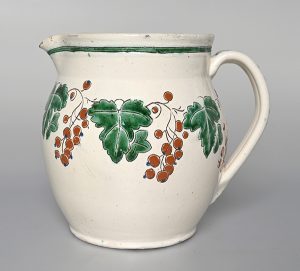

The Museum of Arts and Crafts in Zurich houses another vase from this period (ZHdK-KGS-08457). Both the Historical Museum in Lausanne and the School of Visual Arts and Design in Bern and Bienne each have an unusual milk jug decorated with a red currant motif (MHL AA.VL 2004 C6006 and SfGB 453).

In the autumn of 1905, a large sales exhibition was staged both at the Grand Bazar in Neuchâtel and at the “Maison d’Art” in Geneva (La Suisse Libérale 42, No. 267, 14th November 1905 and 42, No. 296, 17th December 1905) with very favourable reviews by Philippe Godet and Georges Hantz, the Director of the Museum of Arts and Crafts in Geneva, who purchased a number of pieces for his museum.
In June 1906 La Grenette in Lausanne staged the “Second Exhibition of Female Painters from the French-Speaking part of Switzerland”. Nora Gross also exhibited some of her “pretty vases” (La Suisse Libérale 43, No. 132, 10th June 1906). In July 1906 some of her pottery was put on display in the shop window of Georges Clément on Grand’Rue. They were much admired and described in detail (La Liberté, 36, No. 156, 11th July 1906). Her products were also admired and sold in Basel (Illustrierte Schweizerische Handwerker-Zeitung No. 38, 20/12/1906, 613).
In November 1906 some of her products were put on display in the Weil art dealership on Bahnhofstrasse in Zurich and were very favourably reviewed by the NZZ newspaper (Neue Zürcher Zeitung, archive) on 20th November 1906. The same article also contains a description of a trip to visit the Loder-Walder workshop in Heimberg in the summer of 1904.
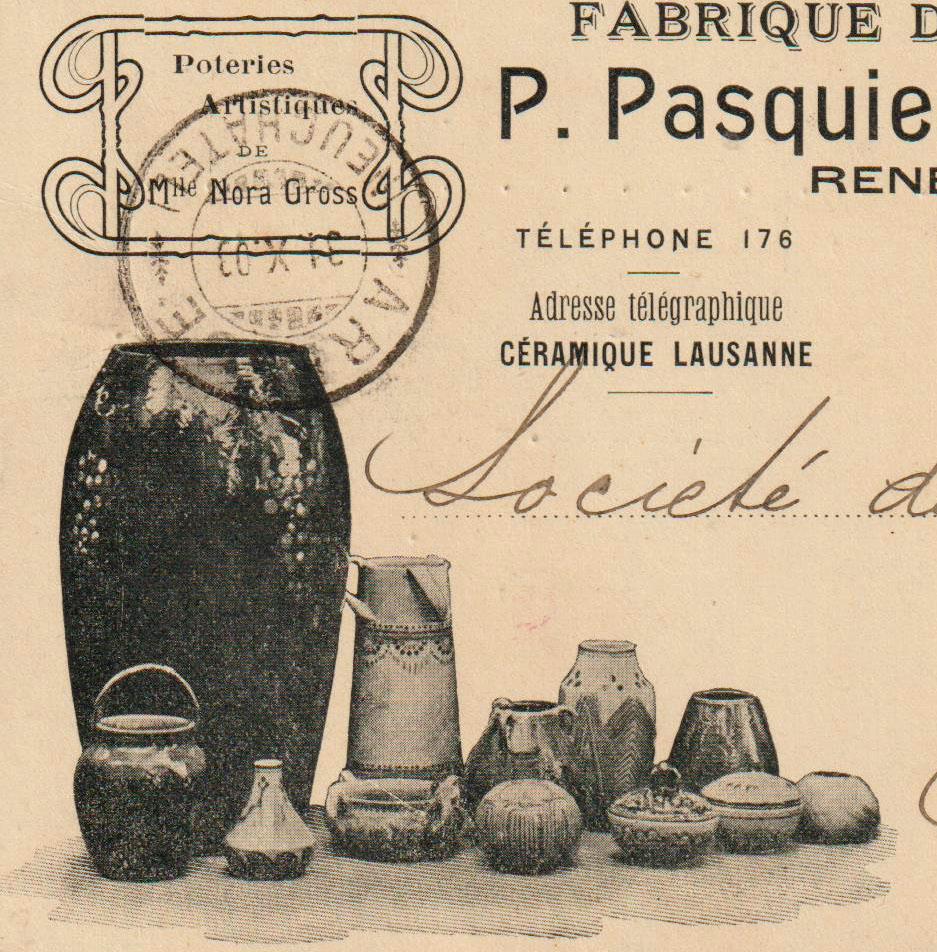
Postcard from 1908, “Fabrique de poterie P. Pasquier-Castella”.
In 1907 the Indicateur Vaudois, in its section on the pottery factories of Renens, published an advertisement that read “Fabrique de poterie P. Pasquier-Castella – Utilitarian ware, vases, chimney pipes and pots, drainage and sewage pipes – Studio pottery by Miss Nora Gross” (p. 389). Pasquier, the new leaseholder of the Renens pottery factory, was not content with producing only traditional products but also tried to introduce a truly artistic line designed by an independent artist. The advertisement shown above, however, is one of the very few mentions of this collaboration that we could find.

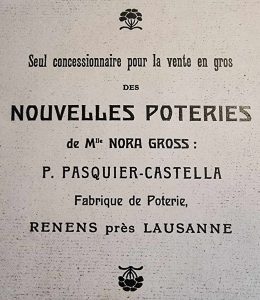
Another source is a paper on the pottery by Nora Gross written by Edmond Gilliard, which probably dates from the same period. On the back of the advertising brochure, we again find a reference to Pasquier-Castella declaring himself to be the sole agent for Nora Gross’s ceramics. Almost the same text was published a second time in 1913 in the Blätter für den Zeichen- und gewerblichen Berufsunterricht – Revue suisse de l’enseignement professionell 38, Heft 8, 60-63, a journal for arts education and vocational schools.
This collaboration was probably short-lived, and we have not been able to identify any objects that would attest to it (see also «Les poteries de Renens und Chavannes-près-Renens»).
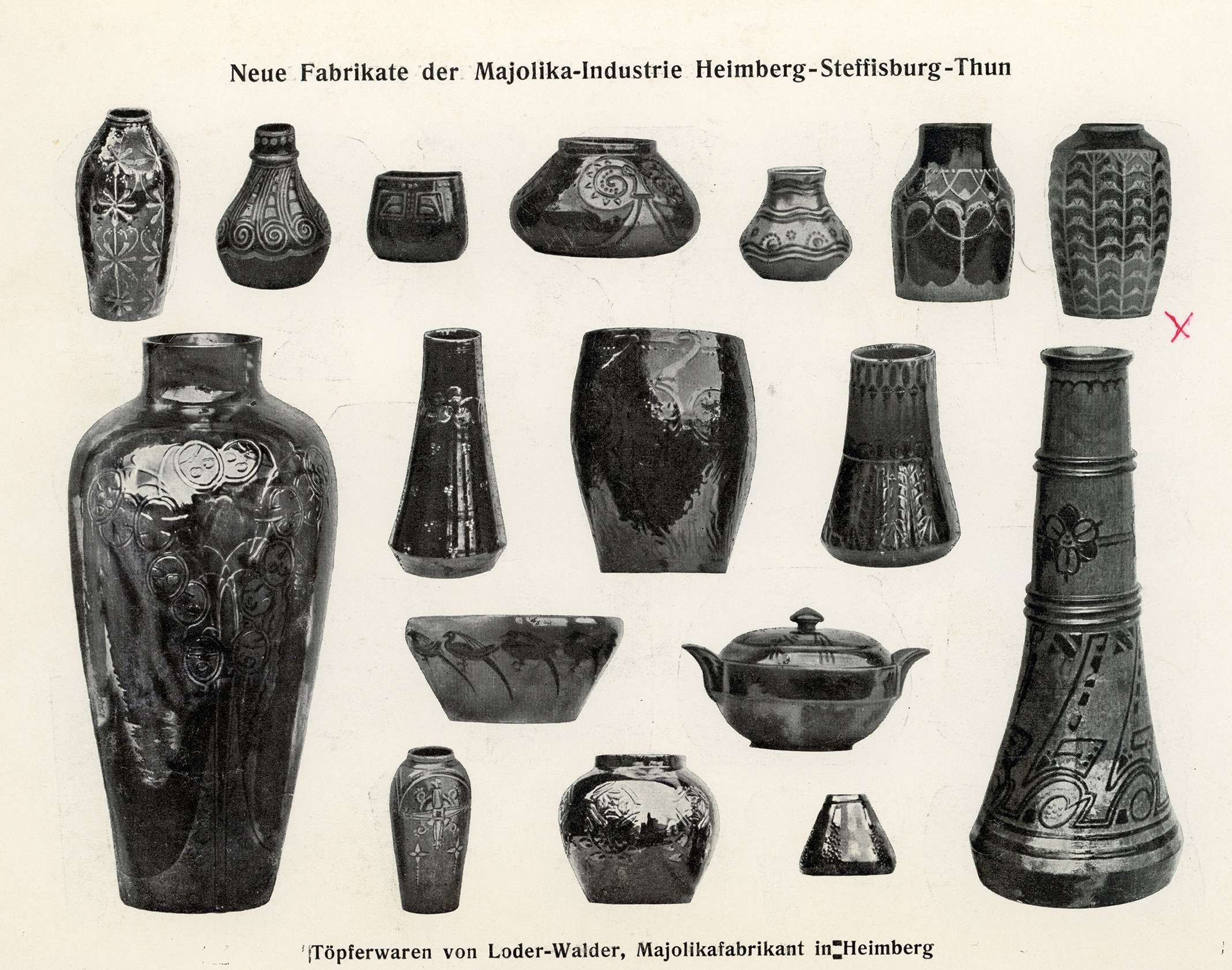
Ceramics by Bendicht Loder-Walder and Nora Gross presented at the Christmas Exhibition of the Museum of Arts and Crafts in Bern in 1907 (Jahresbericht 1907 des Kantonalen Kunstgewerbemuseums Bern).
Bendicht Loder-Walder’s death in November 1909 did not mean the end of the production of Nora Gross’s designs for the workshop as it continued to operate and probably continued to employ the same pottery paintresses. This is may be further attested to by an exhibition staged in 1911 by the Société des peintres et sculpteurs suisses, the Swiss Society of Painters and Sculptors, at the Kunsthaus Museum in Zurich. The ceramic works by Nora Gross were described by Albert Baur, chief editor of the journal Wissen und Leben (Schweizer Monatsschrift für allgemeine Kultur, Vol. 8, 1911, 160), as “interesting ceramic works”. The NZZ newspaper, too, reported on the exhibition, specifically mentioning the fact that the pieces were made by Loder-Walder (9/4/1911, 20/4/1911, 29/4/1911). The notion that production continued at Loder-Walder’s workshop is also supported by statements made by Paul Wyss (1914, 150). A number of exhibits made by Loder-Walder to the designs of Nora Gross were put on display as part of the ‘23rd Group: Ceramics and Glass’, at the Bern State Exhibition in 1914. A comment in the list of exhibitors shows that Nora Gross’s ceramic designs were produced by pottery paintresses from the Loder-Walder workshop. It is interesting to see that Loder-Walder’s new collection was still identified as majolica: “Loder Brothers, Pottery, Heimberg. Production of majolica with the artistic cooperation of Ms. Nora Gross, Lausanne. Prompt execution according to her designs” (cited after Messerli 2009, 70). In this context, the technical report on the State Exhibition (Volume VI on Group 23, p. 73) offers the following critique: “The Loder Brothers from Heimberg exhibited ceramic wares to the designs of Ms. Nora Gross, Lausanne. Not much was new; we had encountered most of the exhibits at smaller arts and crafts exhibitions previously staged by the artist herself.”
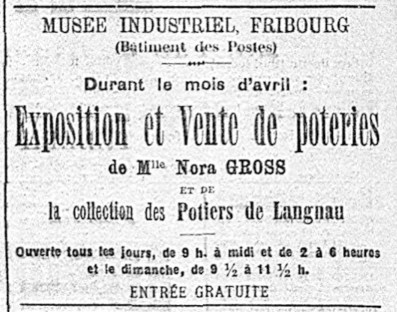
In April 1911 the Industrial Museum in Fribourg staged a sales exhibition of products by Nora Gross and the “potters from Langnau”, though none of the latter were mentioned individually. The exhibition was reviewed in detail by Hélène de Diesbach in La Liberté dated 11th April 1911. While the exhibition was on, Georges Clément sold ceramics by Nora Gross in his shop at 10 Grand-Rue in Fribourg. In his advertisements he put a special emphasis on the large range of vases (La Liberté 12/4/1911, 14/4/1911). The exhibition ran until October of that year (La Liberté , 31st August 1911).
Also in 1911, Nora Gross participated in the exhibition “L’art domestique” at the Museum Rath in Geneva (Ball-Spiess 1987, 152; Michelle Biéler, Wissen und Leben, Vol. 9, 1911, 422-423). On 31st October 1911 she was one of the founders of the Société d’art domestique (Swiss Official Gazette of Commerce, SOGC 29, No. 299, 2012).
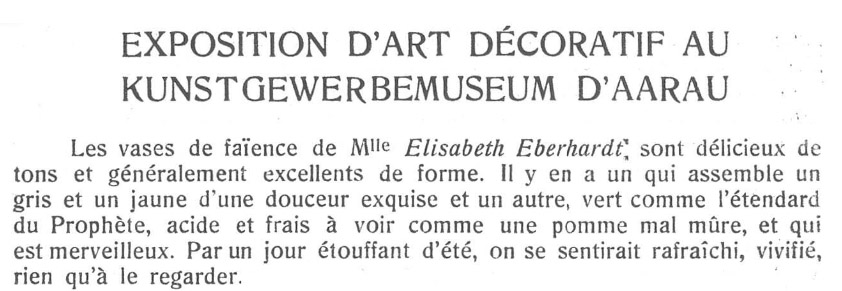
Wissen und Leben, Vol. 11, 1912-1913, 374.
In 1912, Nora Gross wrote a very favourable review of works by Elisabeth Eberhardt, which were on display at the Museum of Arts and Crafts in Aarau.
In December 1912 Nora Gross exhibited between two and three hundred of her ceramics at the Lausanne bookshop Le Petit-Chêne: “none of them look the same […] The pottery genius has an inexhaustible stock of shapes and decorations. The pots alternate between a Japanese, Egyptian, Persian, Etruscan and central Swiss style while retaining their special character which makes up the N. G. brand. It is a garden of variety and colour. Various reds ranging from burnt Terra di Siena to Indian red, strawberry red, cherry red, brick red and vermillion; green hues including light green, apple green, pistachio, moss, olive and emerald green […]” (Gazette de Lausanne dated 31st December 1912, 5; Ball-Spiess 1987, 152). Reading the enthusiastic description, we cannot but recognise the limitlessness of Nora Gross’s ceramic palette.
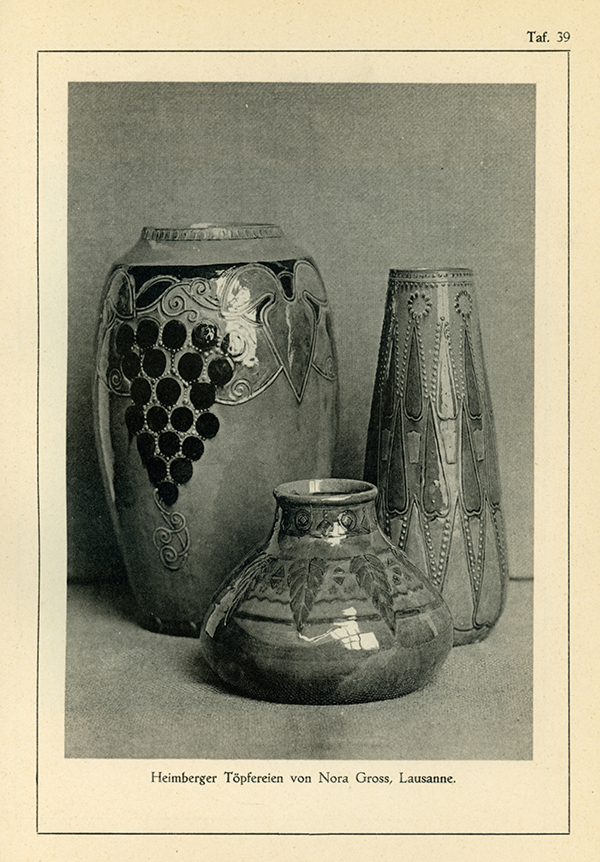
Pottery, designed by Nora Gross and produced in Heimberg (Anner 1916, plate 39). Who collaborated with Nora Gross in Heimberg after Bendicht Loder-Walder passed away in 1909? Were all these pieces manufactured by Christian Frank-Jenni at the time (see below)?
A book entitled “Die kunstgewerbliche Arbeit der Frau in der Schweiz – L’artisanat d’art des femmes en Suisse” (Anner 1916) named Nora Gross, Elisabeth Eberhardt (from Lenzburg, Canton of Aargau), Anna Müller (from Grosshöchstetten, Canton of Bern), Frieda Lauterburg (from Langnau in the Emmental valley, Canton of Bern) and Elisabeth Gött-Strasser (from Munich, Germany) as some of the prominent ceramicists in Switzerland.
Between 1916 and 1918, Nora Gross was experimenting with a different type of pottery, namely industrially produced refined white earthenware. To this end, she was now sending sketches of shapes and decorations to the Manufacture de poteries fines de Nyon, which, until 1917, was run by Jules Michaud and then by his son Louis (Pelichet 1985/2, 36). These new products were presented to the public in 1916 as part of a touring exhibition staged by L’Œuvre entitled “Arts du feu”. The objects by Nora Gross included a black-and-white service, tea caddies, bowls and bonbonnières (Gazette de Lausanne dated 27th May 1916, 3 – Les arts du feu 1916, Cat.-No. 141–145).
Photographs of the exhibition in the Galeries Léopold-Robert, Neuchâtel:
Photo – ceramics by Nora Gross, photo, photo, photo, photo
In a report on another exhibition staged by L’Œuvre entitled “Exposition d’intérieurs ouvriers” in Lausanne in 1918, the author – none other than Paul Perret, Nora Gross’s future husband – mentioned “a dinner service and a coffee set with black and white decorations designed by Ms. Nora Gross and produced by the Michaud Pottery in Nyon, a fine example of what can be achieved when art and industry enter into an effective collaboration.” (Tribune de Lausanne, 3rd December 1918, 2).

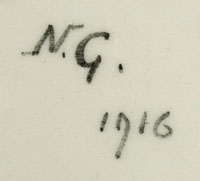
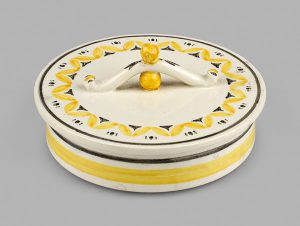
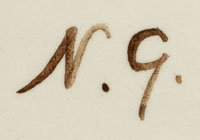

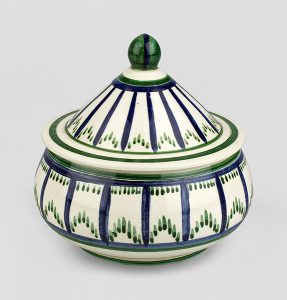
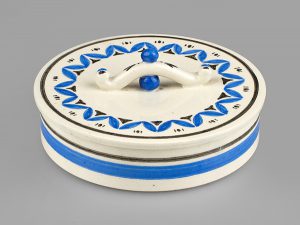

Ceramics by Nora Gross from the Manufacture de poteries fines de Nyon, run by Jules Michaud.
So far the only examples of this type known to be in a public collection are in the Historical Museum in Lausanne: three bonbonnières (MHL No. 13; MHL No. 11), two boxes (MHL No. 15; MHL No. 16), a small vase (MHL No. 27) and a cylindrical box dating from 1916 (MHL No. 24). All bear the painted mark “N. G.”.
In 1916, Nora Gross was invited to teach at the Swiss School of Ceramics in Chavannes-près-Renens: an announcement in the Feuille d’avis de Lausanne dated 10th June 1916, p. 23, mentions that she has been appointed by the Council of State to teach drawing. The tenure would be short-lived.
The Historical Museum in Lausanne is also the only public institution that houses objects which resulted from another collaboration: five pieces in their collection bear an incised mark that reads “Nora Gross – C. F.J.” and an incised model number (MHL No. 19; MHL No. 20; MHL No. 21; MHL No. 22; MHL No. 23). Daniela Ball identified this workshop as that of Christian Frank-Jenni in Steffisburg. Christian Frank (1865-1950), descendant of a family of potters that had been resident in Steffisburg since the early 19th century ran a pottery on Untere Bernstrasse with his wife Bertha, née Jenni (1864-1946) (Buchs 1988, 98).
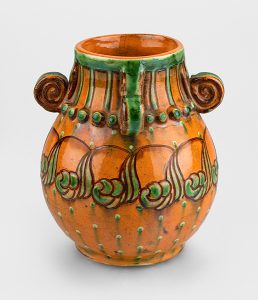
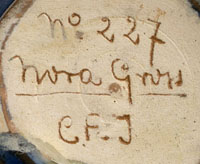

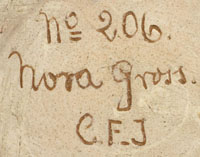
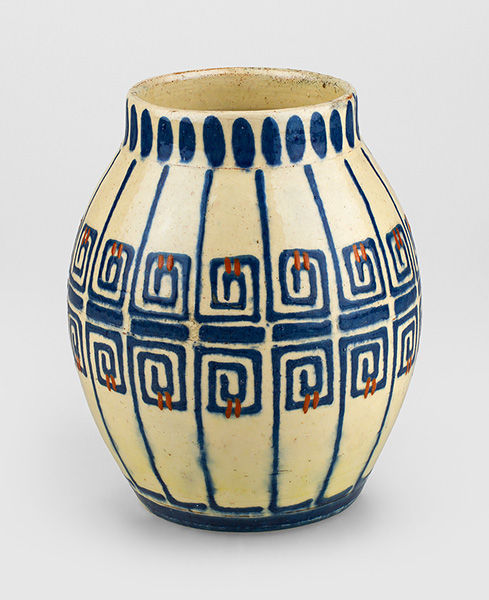
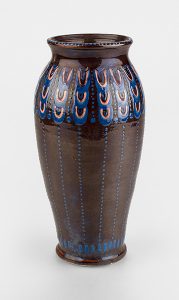
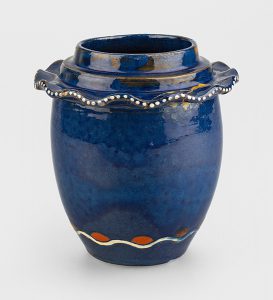
To date, this collaboration has only been attested to by these few examples from the MHL. Daniela Ball dated its beginning to around 1918 (Ball 1987, 114). The old museum inventories mention a piece that had been acquired from the Museum of Arts and Crafts in 1919. It was said to bear the inventory number 885 and the mark “C. F. J.”, but unfortunately, we could not locate it.
After 1918/1920 Nora Gross appears to have concentrated once again on other decorative techniques such as watercolour painting and textile printing (for a list of exhibitions between 1919 and 1924 see Ball-Spiess 1987, 152-153), although she is known to have participated in a pottery exhibition held at the Wolfsberg art gallery on Bederstrasse in Zurich in 1921 (Das Werk – L’Œuvre 8, 1921, Vol. 4, XVIII).
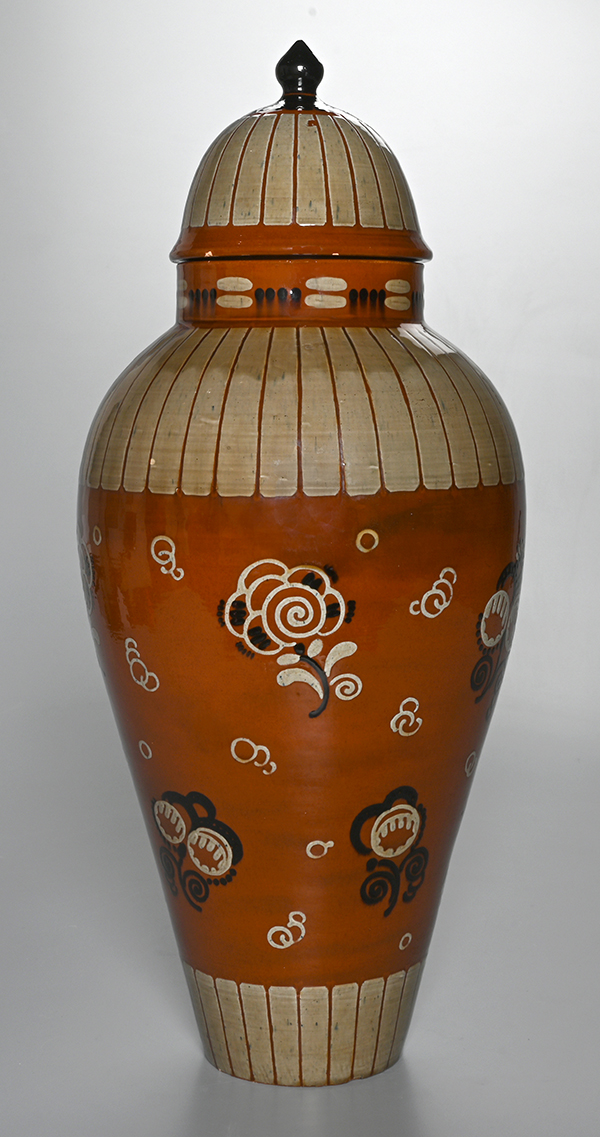
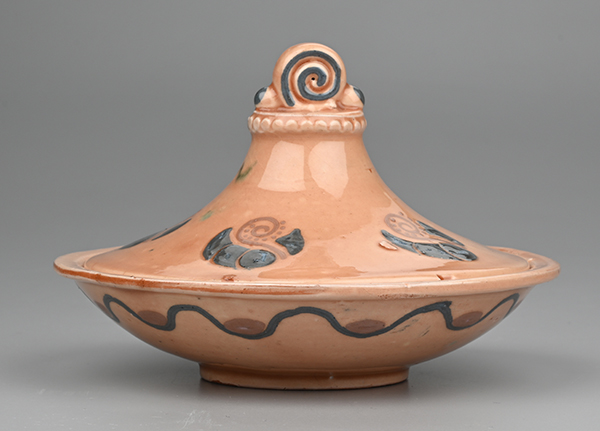
In 1922 she put forward 46 objects for display at the First National Exhibition of Applied Arts staged by L’Œuvre in Lausanne. It was a major event, and she was one of its main contributors (Cat. No. 138-169). Daniela Ball believed that these ceramics were made at the Swiss School of Ceramics in Chavannes-près-Renens, Canton of Vaud thanks to the close ties Gross maintained with those who ran the institution (Ball 1988, 125). The Musée Ariana houses a bonbonnière, which was acquired at the 1922 exhibition (Inv. C 0797 – Ball 1988, Cat. No. 28), and a lidded vase which was ordered on the same occasion but not delivered until the following year (Inv. C 0800 – Ball 1988, Cat. No. 29). Both specimens bear the incised mark “nora Gross” together with a model number.
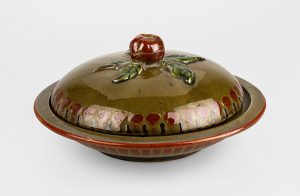

The Historical Museum Lausanne has another bonbonnière (MHL No. 12), which is relevant in this context and was probably also made in 1922. It bears the same mark as the bonbonnière at the Musée Ariana.
In 1923 another small exhibition which included ceramics by Nora Gross was staged in Lausanne by L’Œuvre and the Schweizerischer Werkbund (Das Werk– L’Œuvre 10, issue 11, XVI). That same year, some of her ceramics were also presented at an exhibition curated by the Swiss Association of Female Painters and Sculptors in Geneva (Le mouvement féministe : Organe officiel des publications de l’Alliance nationale des sociétés féminines suisses 11, 1923, 39).
Translation Sandy Haemmerle
References:
Anner 1916
Franziska Anner, Die kunstgewerbliche Arbeit der Frau in der Schweiz, Chur 1916.
Ball-Spiess 1987
Daniela Ball, “Wie ist das Kunstgewerbe in der Schweiz zu heben und zu pflegen?” Der Beitrag von Nora Gross (1871–1929) zur ästhetischen Erziehung. Dissertation, Phil.-Hist.-Fakultät Universität Basel. Dissertationsdruck Bern 1987.
Ball 1988
Daniela Ball, Nora Gross (1871-1929). Genava 36, 117-135.
Barten 1998
Sigrid Barten, Nora Gross, in: Cerâmica da Suìça do Renascimento aos nossos dias. Ceramics from Switzerland from Renaissance until the Present. Museu Nacional do Azulejo, Lissabon 1998, 141-146.
Buchs 1988
Hermann Buchs, Vom Heimberger Geschirr zur Thuner Majolika. Thun 1988.
Edmond Gilliard, Les nouvelles poteries de Nora Gross, Revue suisse de l’enseignement professionel 15.4.1913, S. 61
Les arts du feu 1916
Exposition des arts du feu. Verrerie, céramique, émaux, vitraux, mosaïque. Cat. d’exposition, Genève/La Chaux-de-Fonds/Neuchâtel/Zurich/Lausanne 1916.
Messerli Bolliger 1991
Barbara E. Messerli Bolliger, Der dekorative Entwurf in der Schweizer Keramik im 19. Jahrhundert. Zwei Beispiele: Das Töpfereigebiet Heimberg-Steffisburg-Thun und die Tonwarenfabrik Ziegler in Schaffhausen. Keramik-Freunde der Schweiz, Mitteilungsblatt 106, 1991, 7-100.
Pelichet 1985/2
Edgar Pelichet, Les charmantes faïences de Nyon. Nyon 1985.

